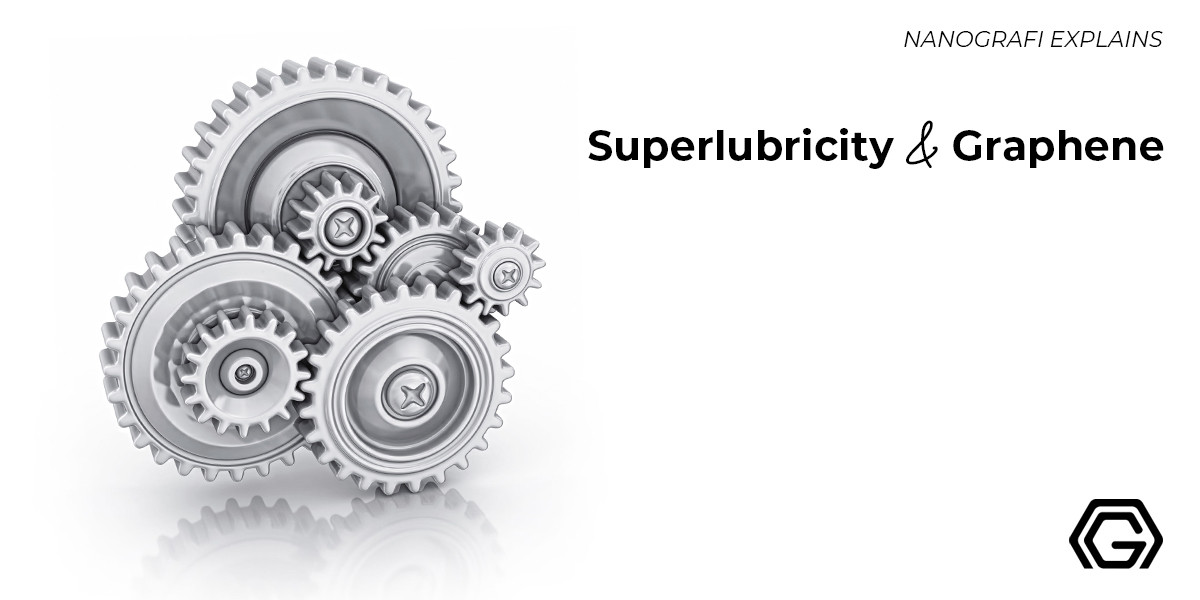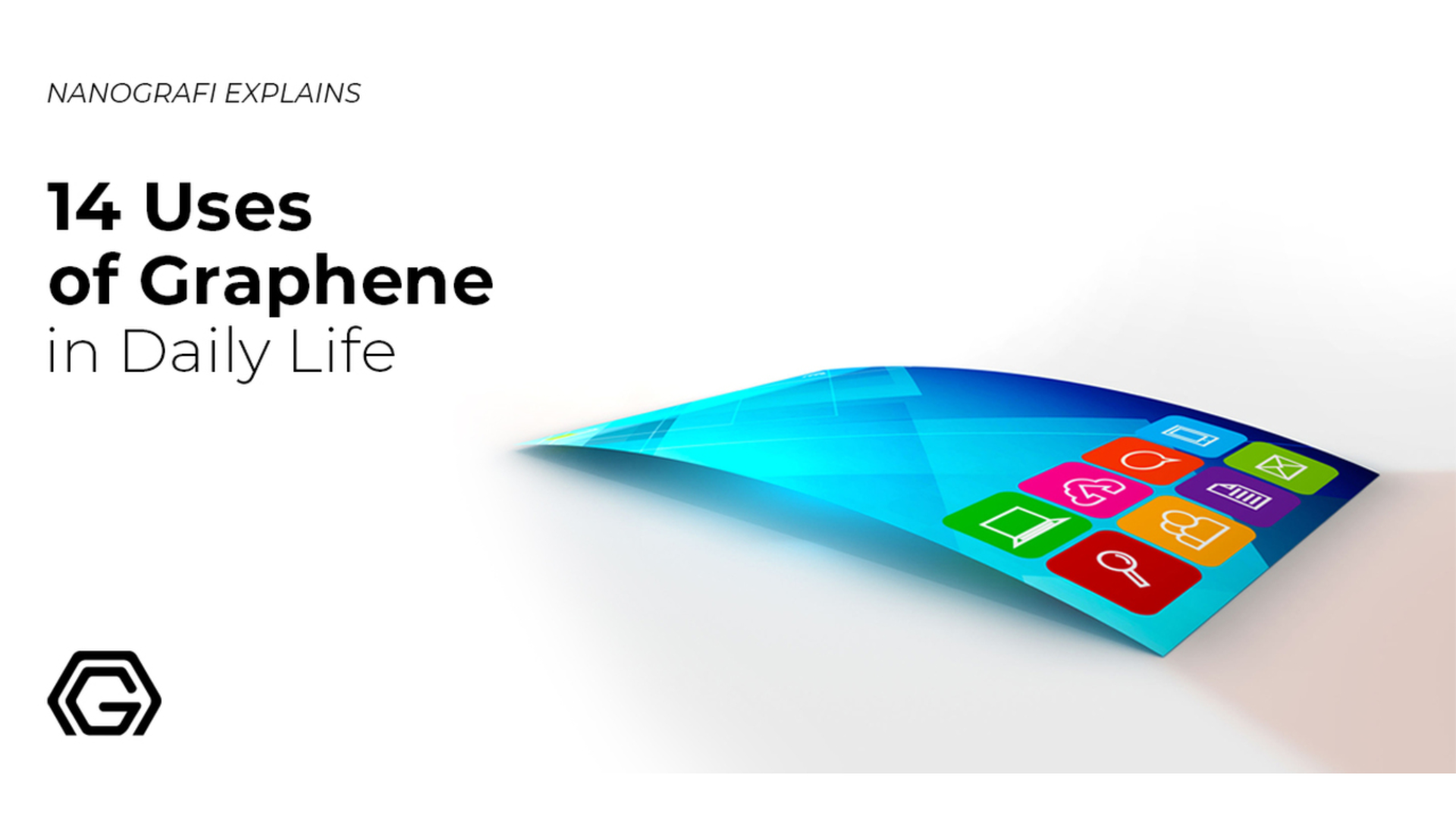Superlubricity and Graphene
Superlubricity is one of the attractive subjects in the science and engineering community. Amongst the promising super lubricants, graphene holds an important place due to its excellent structural, mechanical, and chemical properties.
The superlubricity of graphene is utilized both in solid and liquid lubrication.
Introduction
Graphene is ranking as one of the most popular materials of the 21. century. This atom-thick 2D material arranged in a hexagonal structure is made up of carbon atoms and show unique properties. Graphene is usually obtained from graphite through the top-down approach or from molecular growth through the bottom-up approach. The top-down approach includes the exfoliation of graphene sheet from a bulk of graphite while the bottom-up approach includes various chemical methods such as chemical vapor deposition (CVD) or epitaxial growth. Each of these methods provides graphene flakes of different qualities and dimensions. Graphene exhibit some excellent properties such as high strength, great thermal and electrical conductivity, chemical stability, and optical transmittance. Additionally, the unique antiwear and friction reduction properties of graphene have become the center of researches. Based on these properties, graphene is considered to be a great super lubricant. What is superlubricity? It is defined as a sliding regime in which the friction or resistance to sliding nearly vanishes. The friction coefficients of super lubricant materials can go as low as 0.001. Graphene not only has a low friction coefficient at different values depending on the scale and the number of defects it is also impermeable. The impermeability of graphene provides protection against corrosion and oxidation improving its superlubricity. These properties of graphene are utilized in both solid and liquid lubrication. Furthermore, superlubricity is not limited to graphene, it is also observed in graphene-like structures such as graphene oxide (GO) and reduced graphene oxide (rGO).
Graphene in Solid Superlubrication
The excellent low surface energy, mechanical strength, and atomic smooth surface of graphene make it a great solid super lubricant at nano, micro, and macro scales. The friction coefficient of graphene at nano and micro scales is as low as 0.01 while at micro scales it is found to be around 0.1. Single-layer graphene exhibits anisotropic friction behavior.The superlubricity behavior of graphene at nano and micro scales is often observed by utilizing an atomic force microscope (AFM). Frictional behavior between graphene/graphene, graphene/hexagonal boron nitrate (h-BN), and graphene/gold is studied by coating the AFM tip with single or multiple layers of graphene. One of the most important findings of studies shows that the low friction coefficient of graphene is strictly related to the adhesion strength between the graphene and the substrate. At lower adhesion strength, the integrity of the graphene structure was demolished in time due to higher friction between the surfaces. Adhesion strength can be affected by a number of factors, one of which is the substrate surface morphology. Graphene shows better adhesion to the surfaces that are atomically smooth. Hence, the treatment of the substrate surface holds an important place in improving the superlubricity of graphene. For example, plasma treated surfaces enhance the adhesion of graphene through van der Waals force. The superlubricity of graphene could be realized up to a certain contact pressure limits after which the friction coefficient increases significantly. This limit is dependent on the type of substrate and the quality of graphene. However, superlubricity can be restored after the contact pressure is reduced back. The lowest friction coefficient is observed between two graphene layers reaching a value of 0.003.
Even though graphene shows great superlubricity at nano and micro scales, the superlubricity at the macro scale is much more relevant to the engineering applications. Hence, a substantial amount of studies have focused on the superlubricity of graphene at the macro scale. Graphene reduces friction and tribo-corrosion which also provides an anti-wear property. The studies show that few-layer graphene provides a better macro scale superlubricity and durability than single-layer graphene. The macro-scale lubricating behavior of graphene is also dependant on the environmental factors. The friction coefficient is much lower in hydrogen and humid environments than in the pure nitrogen environment. The better lubricating behavior can be attributed to the passivation of graphene by H or OH in hydrogen or humid environments. Much like few-layered graphene, graphite also provides superlubricity. The layered structure of graphite allows the sliding behavior of interlayer planes. The friction behavior of graphite is often observed with AFM or friction force microscope (FFM). For example, the friction force between graphite and tungsten tip is found to be 0.005. The excellent superlubricity of graphite at the nanoscale is not surprising. However, graphite unexpectedly shows great superlubricity at the micro scale as well. The interlayers of graphite do not undergo permanent dislocations; rather the layers self-retract to their original condition due to the tendency to minimize the surface free energy.
Even though graphene and graphite or multilayered graphene show excellent superlubricity, they have a limitation due to the chemical inertness of their structure and p-p interactions between layers. To overcome these drawbacks, functionalized graphene materials such as GO, rGO, fluorinated graphene (FG), or hydrogenated graphene (HG) are investigated for solid superlubrication. Amongst these functionalized structures GO is the most commonly utilized one due to its low cost and ease of production. However, functionalized graphene materials could not compete with the low friction coefficient of graphene. Composites of graphene were also studied to reduce the friction coefficient. The most promising composites include graphene/nanodiamond particles, graphene/C60/graphene layered structures and ultrahigh molecular weight polyethylene (UHMWPE)/graphene.
To get more information about the application areas of graphene,
you can read our blog post here.
Graphene in Liquid Superlubrication
Aside from solid lubrication, graphene has also been reported to perform great liquid lubrication. Liquid lubrication is widely used in the industry to ensure better performance of machinery. However, in today’s technology, the performance of current liquid lubricants may not be sufficient. In order to enhance the performance of liquid lubricants often additives are incorporated into the formulation of base lubricant material. These additives generally provide corrosion resistance; wear resistance; pressure agents, however, they do not provide a reduction in the friction coefficient of the lubricant. On the other hand, graphene provides friction reduction and anti-wear properties due to its superlubricity. Nano and microscale graphene flakes form surface interactions with the liquid molecules altering the behavior of the lubricant. The addition of graphene to the water medium lowers the friction coefficient to 0.001 allowing superlubricity. Even lower friction coefficients can be achieved by using different types of liquid lubricants. For example, with the addition of graphene, the friction coefficient of hydrophobic self-assembled fluoroalkyl monolayers (SAFMs) is lowered to 0.0003. Graphene-like materials are also utilized to obtain superlubricity in liquid media. Both rGO and GO are found to be valuable superlubricity additives decreasing the friction coefficient and wear formation. These graphene-like materials are used as additives in mineral oils, base oils, engine oils, ionic liquids, or water based lubricators. GO nanosheets show better performance under higher sliding speeds. The reducing effect of graphene or graphene-like materials on friction coefficient mainly depends on the concentration of graphene, rGO, or GO as well as the supporting materials such as copper that provide better interaction.
Conclusion
Recently, superlubrication has been a hot topic in the science community. Achieving superlubricating behavior in lubrication materials prolongs the life-time of machinery and reduces the malfunctions during operation. Graphene is considered to be one of the best candidates in both solid and liquid superlubricity. The low surface energy, mechanical strength, and atomically smooth surface of graphene make it a great super lubricant. Single-layer graphene exhibits anisotropic friction behavior. Graphene shows different friction coefficients at nano, micro, and macro scales; on different substrates; and in different environments. The friction coefficient of graphene in solid superlubrication generally ranges between 0.01 and 0.1. On the other hand, it is possible to reach a friction coefficient as low as 0.001 in liquid superlubrication. Graphene is mainly used as an additive to reduce the wear and friction coefficient of liquid lubricants such as mineral oils, base oils, engine oils, ionic liquids, or water based lubricators.In addition to pristine graphene; graphene-like materials including graphite, GO, rGO, HG, and FG are also utilized in both solid and liquid superlubrication. However, these materials fail to compete with the low friction coefficients of pristine graphene. The main factors affecting the graphene superlubrication are the concentration of graphene materials, layer numbers, applied loads, and sliding speeds. All in all, graphene is proved to be a great super lubricant material. The studies on graphene solid lubrication are vast and detailed. On the other hand, the studies on the graphene liquid lubrication are still at the starting stages and require improvements.
To get more information, you can visit Blografi.
References
1.Liu, Y., Ge, X., & Li, J. (2020). Graphene lubrication. Applied Materials Today, 20, 100662.
2.Chen, X., & Li, J. (2020). Superlubricity of carbon nanostructures. Carbon, 158, 1-23.
3.Van Wijk, M. M., de Wijn, A. S., & Fasolino, A. (2016). Collective superlubricity of graphene flakes. Journal of Physics: Condensed Matter, 28(13), 134007.
4.Sasaki, N., Itamura, N., Asawa, H., Tsuda, D., & Miura, K. (2012). Superlubricity of graphene/c60/graphene interface-experiment and simulation. Tribology Online, 7(3), 96-106.
Recent Posts
-
Nanocomposites in Food Packaging
The utilization of nanocomposites in food packaging represents a significant advancement in the fiel …19th Apr 2024 -
What is the Difference Between 7075 and 6061 Aluminum Alloy?
When comparing 7075 aluminum alloy to 6061 aluminum alloy, it's essential to understand their disti …5th Apr 2024 -
Iron-Air Batteries: The Ultimate Guide
Iron-air batteries represent a significant breakthrough in energy storage technology, offering a sus …29th Mar 2024






